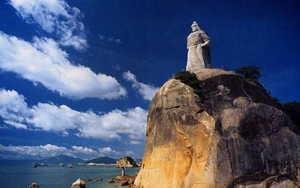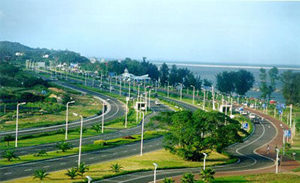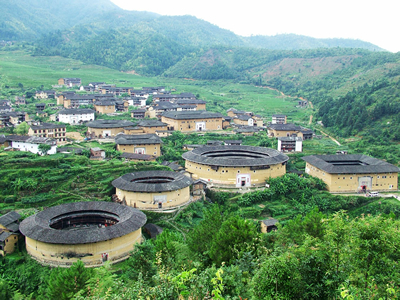| |
|
|
| XIAMEN ATTRACTION |
|
| |
| Gulang Islet |
 |
Gulangyu Island is located just southwest of Xiamen City. Visitors can reach it by steamship from Xiamen City in about 5 minutes. Gulangyu Island is renowned for its delicate natural beauty, its ancient relics, and its varied architecture. The island is on China's list of National Scenic Spots and also ranks at the top of the list of the ten most-scenic areas in Fujian Province.
During the Ming Dynasty (1368-1644), the island was called Yuanshazhou Island'. It got its present name from the huge reef surrounding it. |
|
|
When the tide comes in, the waves pound the reef and it sounds like the beating of a drum. The island came to be named 'Gulang'. Gu in Chinese means 'drum', and Lang, 'waves'.
During the later Ming Dynasty, the troops of national hero Zheng Chenggong were stationed here. After the Opium War in 1842, 13 countries including Great Britain, France and Japan established consulates, churches, and hospitals, turning the island into a common concession. In 1942, Japan occupied the island until the end of the War of Resistance against Japan.
Gulangyu Island has about 20,000 permanent residents, all of whom enjoy a comfortable, relaxing life. Only electric-powered vehicles are permitted on the island, so the environment is free from the noise and pollution of combustion engines. Breathing the clean air, appreciating the ever-present green trees and lovely flowers, anyone here can feel like they are in heaven. With classical and romantic USDopean-style architecture, the island truly deserves to be called the 'Architecture Museum'. It is also known as the 'Cradle of Musicians' and 'Island of Music' because of its reputation for music appreciation.
|
| Zhongshan Road |
 |
Zhongshan Road is one of the most prosperous traditional and comprehensive commercial areas in Xiamen. With a very long history, the architecture along the road is a combined style of East and West.
The large shopping centers, together with a variety of small retail stores here, are characterized by an abundance of items as well as a fairness of price, attracting many tourists. The Buses Nos.2, 3, 4, 10, 12, 23, 25, 27, and 30 pass the road, making it not only easy to get to but also so crowded that many stores are open from nine o'clock in the morning until very late at night. North and South Siming Road and Lady Street nearby are also good places for shopping. |
|
|
| Jimei School Village |
 |
Jimei School Village is located in Jimei District, where is northern suburb of Xiamen City connected to Xiamen Island by a 2,212 meters’ long causeway. Named Xiamen Bridge, this causeway is the first cross-strait bridge in China.
Jimei School Village is a general name for all schools and cultural institutions in Jimei. It was built by Mr. Tan Kah Kee from 1913, containing a complete school system including primary schools, middle schools, high schools, a university, and a series of colleges including Xiamen Aquatic Products College, Jimei Navigation |
|
College, Jimei Finance and Economy Institute and Business Administration College. After decades of development, the village covers an area of over 100,000 square kilometers in total. Now there are more than 10,000 students studying in the college village. Besides been famous for the complete school system and good facilities, Jimei School Village is attractive for blending Chinese architectural style with western architecture style. The unique building group has become a symbol of Jimei School Village. Daonan Lou in Jimei Middle School, Nanxun Lou in Overseas Chinese School and the Teaching Building of Navigation College are three most famous buildings of their unique design. |
| Turtle Garden |
 |
The Turtle Garden was designed and built under the supervision of Mr. Tan Kah-kee in the 1950s and 60s. The architecture and carvings in the garden all reflect his principle of teaching through travel and amusement, and they depict ancient and modern times both in China and foreign countries, taking in the subjects of astronomy, geography, industrial and agricultural production. It is an extensive garden and a profoundly interesting experience. Situated on the southeastern tip of Jimei Town, the Turtle Garden consists of three parts: the portico, the Monument of Liberation, and Tan’s Mausoleum. |
|
The portico is a traditional Chinese style corridor of 20 meters in length, with 58 bluestone carvings of historical figures’ lives studded on both sides. These carvings form the core of the total 633 stone carvings in the garden. There are also 291 carvings on the walls outside the portico, which show a variety of subjects. Many kinds of calligraphy and a charming array of couplets and inscriptions by distinguished persons and masters of these arts also grace the garden, comprising a great treasure trove of Fujian stone carving art.
Passing through the portico, you approach the main building of the garden- the Monument of Liberation. This 28 meter high building was constructed from granite and symbolizes the victory of the Chinese Communist Party after 28 years of fighting. The inscription on the face of the monument was written by Chairman Mao and the back of the monument features calligraphy by Tan Kah-kee. Tan’s Mausoleum is shaped like a turtle’s shell and surrounding the tomb are 15 reliefs depicting scenes from Mr. Tan Kah-kee’s life. |
| Island Ring Road |
 |
The Island Ring Road has a length of nearly 30 kilometres, and is close to the sea. On the side near the sea, there are the Sea Rhythm Platform, the Moon-Playing Slope, the Star-Counting Garden and the Yefeng Village. The Island Ring Road is designed and forested in an artistic way which combines the sea, the beaches and the vegetated area into one, and therefore the Road becomes a spectacular scene of beauty in Xiamen. One of the most interesting ways to get to know Xiamen 's vicinity is to hire a bike and drive on the Island Ring Road.With a fresh wind in your face, the sun on your skin and a beautiful landscape to take a look at, a trip with the bicycle |
|
| really means some fun. Along the Island Ring Road, you will find some major tourist attractions, such as the International Conference & Exhibition Centre, the Taiwan Folk Village, the Music Park , and Hulishan Fort. Xiamen International Marathons is held on the first Saturday of January every year since 2004. The Whole course runs largely through the scenic sections of the city, including Island Ring Road and large landscaped areas, which are flat and considered to be ideal for a marathon race. |
| Botanical Garden |
 |
Xiamen Botanical Garden is set amidst Wanshi Mountain in the southeastern part of Xiamen Island, also known as Wanshi Botanical Garden. It’s an integral part of the Gulangyu Islet – Wanshi Mountain National Key Scenic Spot, covering an area of 4.93 square kilometers. The garden is set on rolling hills and dotted with grotesque rocks, forming a dramatic rocky landscape. The granite boulders throughout the garden are graced with calligraphic inscriptions of ancient men of letters. There are also various provincial- and municipal-level cultural heritage sites in the garden, including the site of execution of Zheng Lian by Zheng Chenggong (Koxinga), the site where Zheng |
|
Chenggong used to read classics, the terrace built in memory of killed soldiers from Penghu. The garden is also home to several of Southern Fujian’s most renowned temples, including the Heaven’s Border Temple, the Wanshi Lotus Temple, and the Eternal Peace Rock Temple.
The garden, first built in 1960, contains more than 6,300 kinds of tropical and subtropical ornamental plants and comprises 10-plus unique smaller dedicated gardens, such as the psammophytes area, the “Palm Island”, the “Rainforest World”, and the araucaria lawn. In 1984, Deng Xiaoping, the chief architect of China’s reform and opening-up drive, personally planted a Nepal camphor on the araucaria lawn. |
| Hakka Earth Building |
 |
The traditional residential buildings in the western part of Fujian Province in south China- Hakka Earth Buildings are named by the UNESCO as the eighth world wonder.
The Hakka were originally immigrants from northern China who settled in the southern provinces. From the 17th century onwards, population pressures drove them more and more into conflict with their neighbors.As rivalry for resources turned to armed warfare, the Hakka began building communal living structures designed to be easily defensible. These houses, sometimes called Tulou, were often round in shape and internally divided into many compartments for food storage, living ancestral temple, armory etc. Among these 300-600 years old buildings, Wuyunlou, built during the Ming Dynasty over five hundred years ago, is still occupied by people. |
|
| Reference Website: |
http://www.travelchinaguide.com/attraction/fujian/xiamen
http://www.amoymagic.com/FJAdv/Roundhouses.htm
http://www.taiwan-guide.org/david/fujian/west.html#yongding
http://www.chinatouronline.com/china-travel/xiamen/xiamen-attractions/Jimei-Turtle-Garden_468.html |
|
|
|
|
|
|